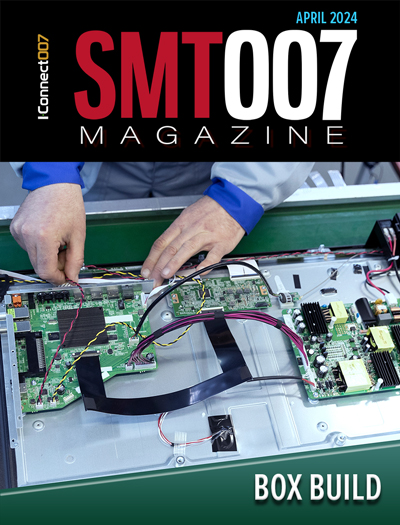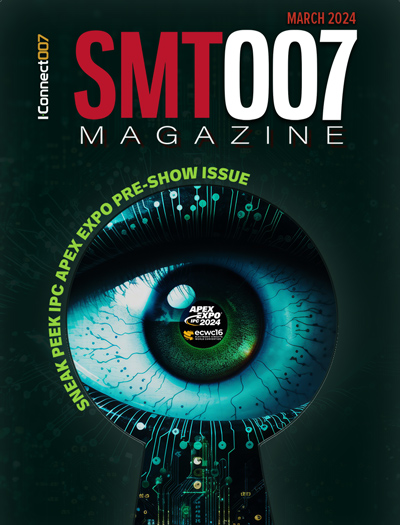-

- News
- Books
Featured Books
- smt007 Magazine
Latest Issues
Current Issue
Box Build
One trend is to add box build and final assembly to your product offering. In this issue, we explore the opportunities and risks of adding system assembly to your service portfolio.

IPC APEX EXPO 2024 Pre-show
This month’s issue devotes its pages to a comprehensive preview of the IPC APEX EXPO 2024 event. Whether your role is technical or business, if you're new-to-the-industry or seasoned veteran, you'll find value throughout this program.

Boost Your Sales
Every part of your business can be evaluated as a process, including your sales funnel. Optimizing your selling process requires a coordinated effort between marketing and sales. In this issue, industry experts in marketing and sales offer their best advice on how to boost your sales efforts.
- Articles
- Columns
Search Console
- Links
- Events
||| MENU - smt007 Magazine
Implementing Digital Twin Best Practices From Design Through Manufacturing Webinar Review
January 27, 2021 | Dana Korf, Korf ConsultancyEstimated reading time: 2 minutes
I-007e recently released a highly informative series of short webinars called Implementing Digital Twin Best Practices from Design Through Manufacturing presented by industry expert Jay Gorajia, the Director of Siemens Global Digital Manufacturing Services. The webinar is an excellent overview how data that is generated using a digital twin model can be effectively utilized to improve business execution using the Siemens tool suite.
The presentation is divided into 12 five-to-six-minute easily understood segments. Each segment walks the viewer through the entire design though manufacturing process and how the information incorporated into the digital model can significantly improve the design manufacturability and shorten manufacturing NPI cycles and product cost.
The digital twin data utilizes the established intelligent ODB++ data format to bi-directionally pass information between the various design though manufacturing operations. They have developed three intelligent integrated ODB++ variants that focus on design, process, and manufacturing information. This provides a closed loop feedback data format which reduces the amount of data translation between different formats effort and reduces potentially inherent errors.
The digital thread is subdivided into six steps. The first is design verification using the Valor NPI analysis software and the Valor Part Library (VPL). These tools are utilized to ensure that the component layout and placement are manufacturable and testable. It also analyzes the base PCB to ensure that it is manufacturable.
The next two steps in the flow are Production Planning to transform the design data to allow the next step, Process Engineering, to properly establish manufacturing process and materials utilizing the integrated dataset. This process setup ranges from establishing which equipment and lines will be required to ensuring that the proper test and inspection operations will be used along with the test and inspection programs and acceptability criteria.
Then the core value of Factory 4.0 automation gathers proper Manufacturing Analytics that are generated from the production process to be added to the Digital Twin data and provided to the final operations and fed back into the NPI software to be used for current design manufacturing improvements. This information is also added to the long-term collective process knowledge database to be used for future designs and process improvements. This allows automation of many existing manual data collection and analysis methods that are currently used. The automation can provide a real time 360-degree view of the manufacturing process, equipment utilization and WIP locations.
The final blocks in this flow are the Production Scheduling and Production Execution operations. These utilize the scheduling input from the operations team and generates and tracks material ordering and inventory. Real life manufacturing is always challenged with material mortgages, unplanned scrap, and equipment downtime. This suite of software potentially allows real time automated responses and reactions instead of waiting to the shift end report to react.
This webinar series presents an excellent overview of the power of an automated Data Twin environment using the Siemens product suite and illustrates how a business can reduce cost, waste and cycle time utilizing this approach.
Additional Resources
- The Printed Circuit Assembler's Guide to ...Smart Data: Using Data to Improve Manufacturing (a free eBook available for download)
- The Printed Circuit Assembler's Guide to… Advanced Manufacturing in the Digital Age (a free eBook available for download)
- Siemens’ free, 12-part, on-demand webinar series “Implementing Digital Twin Best Practices From Design Through Manufacturing.”
- Roundtable RealTime With ... Siemens and Computrol: Achieving Operational Excellence in Electronics Manufacturing
- Lean Digital Thread, the monthly column from Sagi Reuven, Siemens Digital Industries Software
Dana Korf is the principal consultant at Korf Consultancy LLC.
Suggested Items
I-Connect007 Editor’s Choice: Five Must-Reads for the Week
04/19/2024 | Marcy LaRont, PCB007 MagazineFor my must-read picks of the week, I’m highlighting Parker Capers, a young professional seeking employment, solid counsel from Dan Beaulieu on what your post-show plan should look like, more information and insight on “chiplets” and the need for secure data transfer standards from columnist Preeya Kuray, as well as Matt Stevenson’s design for reality wisdom. It’s a reminder to download one of our newest books (there are several) you don't want to miss if you are an assembler.
Absolute EMS Champions Collaboration Between Humans and Robots in Modern Manufacturing
04/19/2024 | Absolute EMS, Inc.Absolute EMS, Inc., an award-winning EMS provider of turnkey contract manufacturing services, offers a perfect factory environment that seamlessly blends robotic automation with human expertise.
ZESTRON Welcomes Whitlock Associates as New Addition to their Existing Rep Team in Florida
04/19/2024 | ZESTRONZESTRON, the leading global provider of high-precision cleaning products, services, and training solutions in the electronics manufacturing and semiconductor industries, is thrilled to announce the addition of Whitlock Associates to its esteemed network of sales representatives.
SEMI Applauds U.S. Chips Act Award for Samsung Electronics Facilities to Strengthen Domestic Semiconductor Supply Chain
04/17/2024 | SEMISEMI, the industry association serving the global electronics design and manufacturing supply chain, applauded the United States Department of Commerce’s announcement of a Preliminary Memorandum of Terms for an award under the CHIPS and Science Act to support the expansion of Samsung Electronics’ presence in Texas and the company’s development and production of leading-edge chips.
Ark Electronics Expands Global Manufacturing Factory Network in North America and Europe
04/17/2024 | PRNewswireElectronic Manufacturing Company Ark Electronics recently announced the expansion of its Global Factory Network with the addition of Electronics Manufacturing Service (EMS) capabilities in Mexico and Europe.


